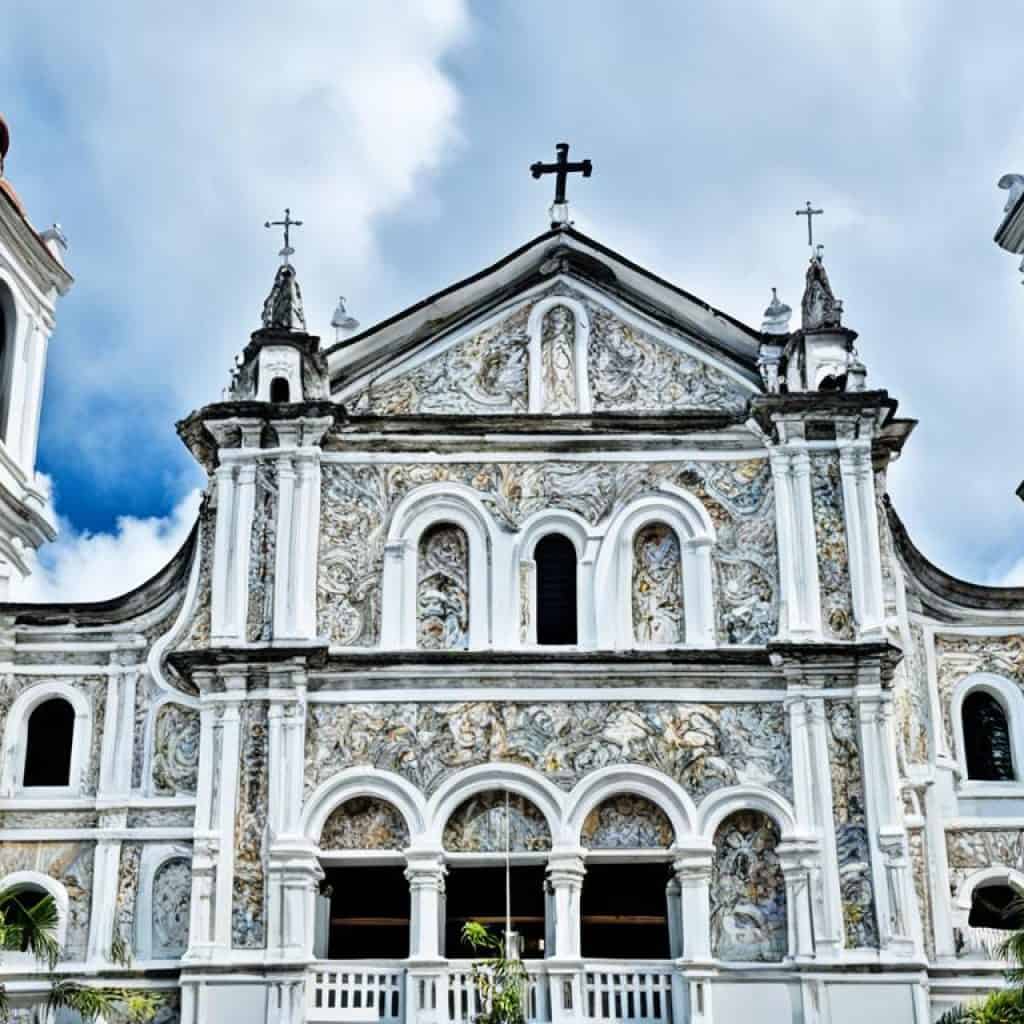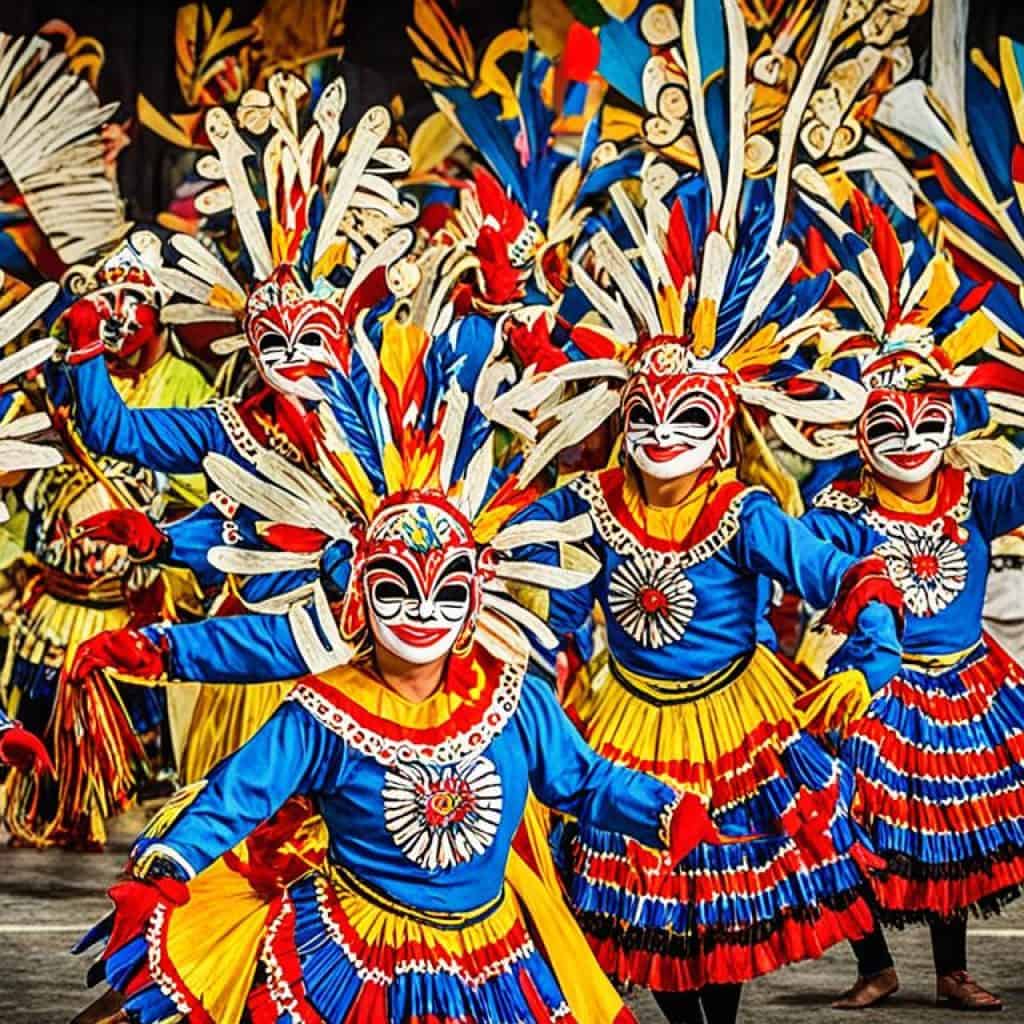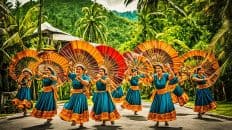Did you know that Bohol, a part of the Philippines, has a deep history and lively culture? This has greatly influenced Filipino heritage. With its beautiful churches and cultural festivities, Bohol shows us a piece of the country’s history and today. Let’s dive into the captivating story of Bohol’s past and culture to discover its hidden gems.
Key Takeaways:
- Bohol is a province in the Philippines renowned for its rich history and vibrant culture.
- The region is home to majestic historical sites and cultural events that showcase the Filipino heritage.
- Bohol’s churches are architectural marvels and hold significant religious and historical value.
- The resilience and faith of the Boholanos are evident in the restoration efforts of the centuries-old churches.
- Exploring Bohol allows you to immerse yourself in Filipino history, tradition, and indigenous culture.
Exploring Bohol’s Religious Heritage
Bohol is famous for its historical sites that offer a peek into its religious past. From neoclassical marvels to Gothic-inspired wonders, these landmarks reveal the architectural diversity and history of the province.
Baclayon Church: A Magnificent Example of Neoclassical Architecture
Baclayon Church is in Baclayon, Bohol, and is a neoclassical beauty. Made with coral stones, it showcases the builders’ skills from that time. Its baroque pulpit and amazing ceiling murals make you feel like you’ve traveled back in time.
Loboc Church: A Centerpiece of Religious and Cultural Landscape
Loboc Church is a key part of Bohol’s religious and cultural scene. It stands as the second oldest church in Bohol, known for its baroque architecture. Despite being damaged in the 2013 earthquake, it has been lovingly restored. This effort has kept its status as a National Cultural Treasure.
Dauis Church is on Panglao Island and blends history with beautiful design. Created in 1863, it has a Gothic style and is filled with neoclassical art. It also offered refuge during World War II. The church is a symbol of Bohol’s rich heritage.
Tagbilaran Church: Preserving Spanish History
Tagbilaran Church, also known as the Cathedral, protects Spanish history in Bohol. It was first built by Jesuits in 1787. With its Neo-Romanesque style and Baroque interiors, it highlights Spanish influence. A visit here offers a deep dive into Bohol’s history.
Dimiao Church: A Glimpse into Colonial History
Dimiao Church, in Dimiao, Bohol, is rich in colonial history. Known as San Nicolas de Tolentino Church, it has a Neo-Baroque style. The church has eye-catching twin bell towers. It’s a must-see for those interested in Bohol’s historical layers.
Panglao Church: A Neoclassical Marvel
Panglao Church is famous for its detailed murals and architectural charm. On Panglao Island, its murals show the sacraments and Holy Trinity. The church shows the local community’s effort to keep their history and culture alive.
Cortes Church: A Blend of Art and Faith
Cortes Church, known as Santo Niño Church, stands out for its artistry and faith blend. In Cortes, Bohol, it combines various architectural styles. Even after earthquake repairs, its old convent’s beauty remains. Cortes Church celebrates Bohol’s dedication to its heritage.
Calape Church: Gothic-Inspired Beauty
Calape Church, or San Vicente Ferrer Parish, is a Gothic beauty in Calape, Bohol. Built between 1933 and 1954, its design includes iconic Gothic elements. Its elegance is a glimpse into the diverse heritage of Bohol.
Loay Church: A Cultural Gem
Loay Church, near the Loboc River mouth, stands out with its separate bell tower. Its neoclassical altars and unique paintings make it special for art and history lovers. Post-earthquake restoration has helped maintain its significance.
Historical Churches in Bohol
| Church | Location | Architectural Style |
|---|---|---|
| Baclayon Church | Baclayon, Bohol | Neoclassical |
| Loboc Church | Loboc, Bohol | Baroque |
| Dauis Church | Panglao Island, Bohol | Gothic |
| Tagbilaran Church | Tagbilaran, Bohol | Neo-Romanesque |
| Dimiao Church | Dimiao, Bohol | Neo-Baroque |
| Panglao Church | Panglao Island, Bohol | Neoclassical |
| Cortes Church | Cortes, Bohol | Blend of Styles |
| Calape Church | Calape, Bohol | Gothic-Inspired |
| Loay Church | Loay, Bohol | Mix of Styles |
These churches provide a unique journey through Bohol’s religious heritage. Their architecture and history make them essential stops for travelers and history buffs.
Baclayon Church: A Neoclassical Marvel
The Baclayon Church is also called the Immaculate Conception of the Virgin Mary Parish Church. It is a neoclassical wonder in Baclayon, Bohol. Founded in 1596 by Jesuit priests, it is important for both religion and culture.
The church is mainly built from coral stones, which are eye-catching. Its design combines neoclassical and baroque styles beautifully. The details show the amazing skill of its creators.
Inside, the baroque pulpit is covered in religious symbols and fancy designs. When you enter, look up to see the ceiling murals. They show biblical scenes with incredible artistry.
“Baclayon Church stands as a testament to the rich history and cultural heritage of Bohol.”
The 2013 earthquake caused a lot of damage to the church. But, thanks to careful restoration, its history and culture are preserved. The people’s efforts in the restoration show their strong spirit.
Today, Baclayon Church is still a place for the faithful to worship. It’s also visited by tourists who want to see Bohol’s heritage. The church is used for cultural events, showing off the area’s lively traditions.
Visiting Baclayon Church lets you see beautiful architecture, learn the area’s history, and understand its cultural importance. This makes it a noteworthy experience for everyone.
Loboc Church: The Jesuits’ Legacy
Loboc Church, known as San Pedro Apostol Church, is essential in Bohol’s culture. Built in 1734, it’s Bohol’s second oldest church and showcases Jesuit architecture.
This church highlights a beautiful baroque style and was key for Jesuits in Loboc. Its design and history attract people globally.
In 2013, an earthquake damaged Loboc Church, like other Bohol sites. But, efforts to rebuild it have been successful, keeping its National Cultural Treasure status.
“Loboc Church stands as a testament to the resilience and determination of the Boholanos to preserve their rich heritage.”
Visiting Loboc Church takes you through history. It lets you see the past’s artistry and craftsmanship. From its details, stained glass windows, to cultural events, it’s a place worth visiting for those exploring Bohol’s heritage.
Reconstruction Efforts
After the earthquake, Loboc Church saw major reconstruction to restore it. The restoration aimed at preserving historical aspects while using modern safety techniques.
Now, visitors see the hard work and precision in the church’s revival. It shows the local dedication to keeping their cultural legacy alive.
Cultural Events
Loboc Church also hosts cultural events that highlight Bohol’s traditions and culture. It is the scene for concerts, choir performances, and festivals, uniting the community.
“The cultural events held at Loboc Church offer a unique opportunity to witness the fusion of faith and art in Bohol.”
By attending, visitors gain insight into Bohol’s spiritual and artistic roots. It offers a way to really connect with the local traditions and community.
Come and Experience Loboc Church
Loboc Church is a must-see in Bohol for its history and beauty. It stands out as a top place for tourists and anyone interested in history.
Entering, you feel sent back in time. You can admire its beauty, tranquility, and spirituality from every angle.
Experience the history and culture of Bohol by visiting Loboc Church. It’s where the Jesuits’ legacy meets Bohol’s vibrant heritage.
Dauis Church: A Blend of History and Artistry
Dauis Church is known as the Church of Our Lady of the Assumption. Located in Dauis, Bohol on Panglao Island, it was built in 1863. The church’s architecture is inspired by the Gothic era, making it a unique place for both tourists and locals to visit.
Once you step inside, you’ll see neoclassical niches, each with important religious icons. The church also has a wooden pulpit, beautifully carved to show the skill of Filipino artisans.
The church has a rich history, especially from World War II. It provided a safe haven for nuns during the war. This makes the place not just beautiful but also historically important.
The 2013 earthquake damaged Dauis Church, but it has been carefully restored. Efforts to fix it show the strong spirit of the Boholano people. Their commitment keeps the church an important cultural and spiritual site.
Explore the Bohol Historical Landmarks
Exploring Bohol’s historical landmarks is a rewarding experience. You should see the stunning Baclayon Church and experience the cultural richness of Loboc Church. These sites offer a look into Bohol’s past and its ongoing cultural journey.
| Church | Location | Architectural Style |
|---|---|---|
| Baclayon Church | Baclayon, Bohol | Neoclassical |
| Loboc Church | Loboc, Bohol | Baroque |
| Dauis Church | Dauis, Bohol | Gothic |
| Tagbilaran Church | Tagbilaran City, Bohol | Neo-Romanesque |
Visiting these landmarks immerses you in the rich history and culture of Bohol.
Tagbilaran Church: Preserving Spanish History
Tagbilaran Church is also known as the Cathedral of Saint Joseph the Worker. It’s a historical gem in Bohol. The Jesuits started it in 1787 and it was later rebuilt in the 19th century. The church stands out with its Neo-Romanesque style, featuring Baroque-style altars and retablos. This preserves its Spanish heritage. Despite changes over the years, including a new convent and bell tower, the church remains a key cultural site in Bohol.
This church showcases the lasting impact of Spanish rule in the Philippines. Its design is packed with exquisite details and religious art. This evokes the past beautifully. The mix of Neo-Romanesque and Baroque elements adds to its allure. It’s a significant place for both worship and cultural reflection.
Tagbilaran Church is also a hub for cultural activities. It hosts religious processions, concerts, and local festivities. These events let people explore Bohol’s rich culture and traditions.
“Tagbilaran Church is not only a remarkable architectural masterpiece but also a symbol of the deep-rooted spirituality and resilience of the Boholanos, as it has withstood natural calamities and the test of time.”
Visiting this church connects you with Bohol’s deep history and heritage. Inside, the peaceful aura and stunning details show the devotion of those who built it. The church is well-maintained, ensuring its stories live on for future generations.
Tagbilaran Church is a stellar pick for anyone into architecture, history, or seeking solace. Its remarkable beauty and importance highlight it as a key historic site. It stands as a symbol of Spanish legacy in the Philippines.
Dimiao Church: A Testament to Time
Dimiao Church is also called San Nicolas de Tolentino Church. It is a beautifully preserved church in Dimiao, Bohol. Built in the late 17th century, it showcases a Neo-Baroque style with twin bell towers.
It has a cruciform structure and a classic facade. These features show off the Philippines’ rich colonial history and architectural skill. The mix of historical importance and architecture makes Dimiao Church a top spot for history lovers.
Panglao Church: Neoclassical Majesty
Panglao Church, also known as Saint Augustine Church, is a stunning example of neoclassical art. It is on Panglao Island in Bohol. Despite delays due to the Philippine revolution against the Spaniards, the community’s effort made it stand tall.
The church is amazing, with its neoclassical style and fine details. Once inside, you see ceiling murals that take your breath away. They show the sacraments and the Holy Trinity, with angels all around. The murals represent the skill of the artists and bring a spiritual feel.
There are old wooden confessionals and beautifully carved retablos at the altar. They make the church feel peaceful and holy. The art shows the dedication and skill of the craftspeople.
Panglao Church is more than a historical site; it is a center for worship and community life. It hosts cultural events that showcase Bohol’s heritage. This church reminds us of the Boholanos’ faith and traditions, which have been passed down for generations.
Cortes Church: A Blend of Art and Faith
Cortes Church, also known as Santo Niño Church, is in Cortes, Bohol. It is a historical site that mixes different architectural styles. Even after damage from earthquakes, it has been restored beautifully.
The church has a white facade with three arched foyers that catch your eye. Inside, a stunning painting by Ray Francia covers the walls. This artwork brings beauty to the church and shows how art and faith come together in Bohol.
Cortes Church tells the story of Bohol’s unique architecture. The mix of styles in the church shows the diverse influences on Bohol. This history makes the church a must-visit for those who love art and history.
The church is key to Bohol’s culture, hosting events like religious processions. It’s where the local people come together to celebrate their faith and traditions. These events show the strong faith and customs in Bohol.
Calape Church: Gothic Beauty in Bohol
Calape Church is known as the San Vicente Ferrer Parish. It is a stunning example of Gothic architecture in Bohol. The Recollects built it from 1933 to 1954, making it stand out.
It’s adorned with pointed arches and rose windows. This church is a true symbol of Bohol’s Gothic beauty. Its grandeur and detailed designs captivate all who see it, showing remarkable craftsmanship.
A historical bell from 1690 is housed within the church. This bell marks the church’s longstanding role in the community. It also highlights the enduring faith of the people.

Key Features of Calape Church:
- Gothic-inspired architecture
- Pointed arches and rose windows
- Historical bell dating back to 1690
Calape Church is a vital cultural and religious site in Bohol. It hosts cultural events and religious celebrations. Both locals and visitors can explore Bohol’s rich history and vibrant traditions here.
Loay Church: A Cultural Gem
Loay Church, also known as the Holy Trinity Church, is on a plateau by the sea. It’s near the mouth of the Loboc River. This church symbolizes the rich history and culture of Bohol.
The church’s design is unique, with a bell tower standing apart from the main building. This distinctive feature adds to the church’s allure.
Inside, visitors see Neoclassical altars and trompe-l’œil paintings. There are also biblical artworks. These features highlight the church’s cultural importance and enchant visitors.
The 2013 earthquake damaged Loay Church, but it has been carefully restored. The restoration preserved its cultural and historical essence. Now, it’s a symbol of resilience and faith, welcoming all to admire its beauty.
“Loay Church is not just a worship place but a reflection of Bohol’s rich cultural heritage. With its unique design and captivating artworks, it’s a must-see for those interested in the Philippines’ historical and artistic wealth.”
If you visit Bohol, make sure to see Loay Church. It represents the perfect mix of architecture, faith, and art. This church showcases the lasting heritage and charm of the province.
| Key Highlights of Loay Church |
|---|
| Unique separate bell tower |
| Neoclassical altars and trompe-l’œil paintings |
| Artworks depicting Biblical scenes |
| Post-earthquake restoration efforts |
Loay Church is truly a Bohol treasure, showing off the province’s rich cultural heritage and artistic achievements. Make sure you experience the history and beauty of this remarkable cultural gem.
Balilihan Church: A Fusion of Architectural Styles
The Balilihan Church started as a simple tabique and nipa building. In the early 20th century, it transformed beautifully. Now, it’s a stunning example of different architectural styles blending together in Bohol.
The church has a unique layout, featuring a grand entrance and a bell tower in the front. Its design is highlighted by a squat octagonal cupola. This feature adds elegance to its appearance.
Walking into the Balilihan Church is like entering a world of art. Inside, Ray Francia’s paintings catch your eye. They mix Corinthian columns, Neo-Gothic spires, and more in a beautiful way. This mix makes the church a special place for visitors and believers.
Look closely at the details inside the Balilihan Church. The various architectural styles tell stories of Bohol’s rich history. They showcase the diverse influences that have shaped this area’s buildings.
The Balilihan Church is a great spot for anyone interested in history, architecture, or finding a peaceful place. The harmony of its design is truly inspiring to see.
Plan Your Visit to Balilihan Church
Want to visit the Balilihan Church? Here are some tips to make your visit better:
- Check the church’s opening hours as they may vary.
- Dress modestly to show respect for the religious significance of the site.
- Take your time to appreciate the intricate details of the church’s interior.
- Consider visiting during a cultural event or religious celebration to witness the church in all its glory.
By visiting the Balilihan Church, you’ll get to see its architectural beauty and understand its importance. It’s an important part of Bohol’s vibrant heritage.
Culinary and Accommodation Recommendations
Bohol isn’t just known for its historical sites. It’s also a food lover’s paradise. The local cuisine lets you dive deep into the island’s culture and traditions. Here are top picks:
1. Cresencia Café
While in Baclayon City, Cresencia Café is a must-visit. It’s cozy and offers a large selection of freshly grilled seafood and Filipino dishes. Enjoy Bohol’s tastes in a welcoming atmosphere here.
2. Luxury Resorts
For a deep dive into Bohol’s heritage, stay at a luxury resort. We highly recommend these two:
- Henann Resort Alona Beach: Here, luxury meets local culture. Enjoy stunning views, top amenities, and excellent service.
- Bohol Tropics Resort: Surrounded by lush nature, this resort shows off Bohol’s culture. Their rooms are comfortable, and the design is inspired by the island’s rich heritage.
Choosing Cresencia Café or a luxury resort means experiencing Bohol’s culture to the fullest. Either way, it will be unforgettable.
Embracing Bohol’s Resilience and Faith
In 2013, Bohol was hit by an earthquake. This event tested the people’s strength and their heritage sites. But, it also showed their deep faith and unity.
After the quake, people quickly worked to fix the old churches. These places are very important to Bohol’s history and culture. Fixing these buildings helped bring the community closer in spirit.
“The restoration of our churches is not just about preserving our historical landmarks, but also about reaffirming our faith and commitment to our heritage,” says Maria Santos, a local resident of Bohol.
The people of Bohol showed great resilience during this difficult time. By working together, they have kept their culture and traditions alive for the next generations.
Fixing the churches was a way for Bohol to honor its past and traditions. This effort reflects the strong bond between their culture and spirituality. It makes Bohol a unique place for both locals and visitors.
To understand Bohol, you need to see its people’s resilience and faith. These qualities reveal the true soul of Bohol. They show its rich history, culture, and traditions.

Additional Information and Travel Tips
When you plan a trip to Bohol, remember some tips for the best experience. Keep these important details in mind:
Best Time to Visit
The cooler months of November to February are ideal for a visit. During these months, the weather is nicer making it great for sightseeing.
Transportation Options
Bohol has several ways to travel around. You can use public transport like buses and tricycles for a cheaper option. But, renting a scooter or car offers more freedom to visit cultural spots.
Respecting Cultural Norms
Remember to dress modestly when visiting Bohol’s churches and sacred sites. It shows respect to cover your shoulders and knees at these places.
Exploring Beyond Historical Churches
There’s more to see in Bohol besides the historic churches. You should also see the beautiful beaches, like Alona and Dumaluan Beach. Also, don’t miss the unique Chocolate Hills and the tiny Philippine Tarsier.
Immerse in Bohol Traditions
Explore Bohol’s local traditions and culture. Try the authentic Boholano food and join in festivals. This will let you really understand Bohol’s rich traditions.
Bohol Travel Tips
| Travel Tip | Description |
|---|---|
| Plan Ahead | Research and plan your itinerary to make the most of your time in Bohol. |
| Stay Hydrated | Bring a water bottle and stay hydrated during your adventures in Bohol’s tropical climate. |
| Protect Your Skin | Apply sunscreen and wear a hat to protect your skin from the sun’s rays. |
| Try Local Delicacies | Indulge in local Boholano dishes like “kinilaw” (ceviche) and “utak-utak” (a traditional rice cake). |
| Learn Basic Phrases | Learn some basic phrases in Filipino or Visayan to communicate with locals. |
Conclusion
Bohol blends history and culture in a unique way. This takes us on a fascinating trip through time. The province is home to ancient churches and buildings. These places are more than just beautiful.
They stand for faith and strength. Places like Baclayon Church and Tagbilaran Church show off the Philippines’ rich colonial past.
But there’s more to Bohol than old buildings. It lets you dive into vibrant traditions and local culture. You can try the food or join in cultural events. Bohol gives a full experience that shows the depth of Filipino heritage.
In Bohol, you find a special mix of history, culture, and nature. It’s not just about seeing beautiful buildings. It’s about celebrating traditions and connecting with the Filipino spirit. A trip here connects you more deeply with the country’s past and culture.


















Add comment